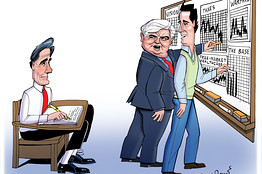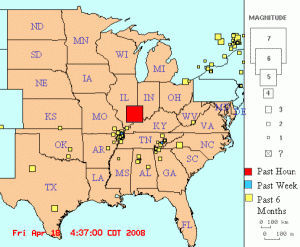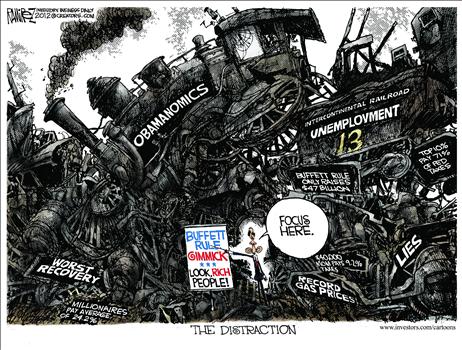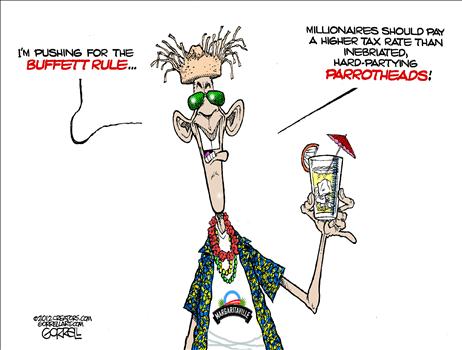It’s Friday, April 13th, 2012….and here’s The Gouge!
First up, the WSJ‘s James Taranto offers his observations on….
The Battle of All Mothers
Hilary Rosen and the misogynistic foundation of contemporary feminism.
 Dimocratic women: do they come in any size other than “large”?!?
Dimocratic women: do they come in any size other than “large”?!?
In a February article about the unwieldily named Democratic National Committee chairman, Debbie Wasserman Schultz, The Wall Street Journal noted that “Obama advisers have occasionally told her to ‘tone it down,’ “ an end toward which she agreed “to enlist two seasoned Democratic female pros, Anita Dunn and Hilary Rosen, to begin giving her occasional political advice and media training.”
One shudders to think what Wasserman Schultz would have said had she, rather than the understated Rosen, been assigned to attack Ann Romney, wife of the presumptive Republican presidential nominee. Even the toned-down version shocked a lot of people.
Here’s what Rosen said on CNN’s “Anderson Cooper 360 Degrees”: “What you have is Mitt Romney running around the country saying, well, you know, my wife tells me that what women really care about are economic issues. And when I listen to my wife, that’s what I’m hearing. Guess what, his wife has actually never worked a day in her life. She’s never really dealt with the kinds of economic issues that a majority of the women in this country are facing.”
Politico reports that male Democratic operatives rushed to Twitter to distance themselves. Campaign manager Jim Messina: “I could not disagree with Hilary Rosen any more strongly. Her comments were wrong and family should be off limits. She should apologize.” Obama adviser David Axelrod: “Also Disappointed in Hilary Rosen’s comments about Ann Romney. They were inappropriate and offensive.”
She has her defenders, too. One is Salon’s Steve Kornacki, who says nasty wingnuts are smearing Rosen by quoting her accurately: “It’s a lot less inflammatory when you consider the context.” Another is Hilary Rosen, who within three hours followed up her initial attack with a defensive screed at the Puffington Host, from which we learned that she doesn’t know the meaning of the phrase “beg the question.” Later she issued a nonapology that misused the word “fulsome.”
It was not just catty and impolite but substantively wrong for Rosen to assert that Mrs. Romney, who raised five sons, has “never worked a day in her life.” Raising children is a lot of work, and we’d venture to say it’s more valuable work than, say, lobbying for the music industry or helping BP with its crisis communications, to name two of the highlights of Rosen’s career. (GASP! A lobbyist….in the Obama Administration?!?)
But we shall resist the urge to pile on Hilary Rosen. It seems to us she deserves thanks for her honesty–for underscoring a sometimes overlooked truth about contemporary feminism.
In an essay for the New York Times last Mother’s Day, feminist historian Stephanie Coontz rebutted the myth “that 50 years ago women who stayed home full time with their children enjoyed higher social status and more satisfying lives than they do today.” Coontz concedes that this was true 150 years ago but argues that by the mid-20th century the disparagement of motherhood was a major theme in American culture:
In the early 20th century, under the influence of Freudianism, Americans began to view public avowals of “Mother Love” as unmanly and redefine what used to be called “uplifting encouragement” as nagging. By the 1940s, educators, psychiatrists and popular opinion-makers were assailing the idealization of mothers; in their view, women should stop seeing themselves as guardians of societal and familial morality and content themselves with being, in the self-deprecating words of so many 1960s homemakers, “just a housewife.”
Stay-at-home mothers were often portrayed as an even bigger menace to society than career women. In 1942, in his best-selling “Generation of Vipers,” Philip Wylie coined the term “momism” to describe what he claimed was an epidemic of mothers who kept their sons tied to their apron strings, boasted incessantly of their worth and demanded that politicians heed their moralizing. . . .
Typical of the invective against homemakers in the 1950s and 1960s was a 1957 best seller, “The Crack in the Picture Window,” which described suburban America as a “matriarchal society,” with the average husband “a woman-bossed, inadequate, money-terrified neuter” and the average wife a “nagging slob.”
Here’s the kicker: “Anti-mom rhetoric was so pervasive that even [Betty] Friedan recycled some of this ideology in ‘The Feminine Mystique’–including the repellent and now-discredited notion that overly devoted mothers turned their sons into homosexuals.”
Now, this is a clever bit of misdirection on Coontz’s part. She makes Friedan out to be a passive receptacle of “anti-mom rhetoric,” which even led her to say things about homosexuality–in 1963, an obscure and poorly understood subject–that her admirers find embarrassing today.
In truth, anti-momism was the very heart of “The Feminine Mystique.” Friedan’s argument was that motherhood and homemaking were soul-deadening occupations and that pursuing a professional career was the way for a woman to “become complete.” She agreed with the midcentury misogynists that a stay-at-home mother was, in Friedan’s words, “castrative to her husband and sons.” But she emphasized that women were “fellow victims.”
The book might as well have been titled “Why Can’t a Woman Be More Like a Man?” Today, of course, she can, and because feminism has entailed a diminution of male responsibility, she often has no choice. As we’ve noted, an increasing number of women are choosing domestic life, finding it a liberating alternative to working for a boss. But to do so requires a husband with considerable means.
Fifty years ago, Ann Romney’s life would have made her just a regular woman. Today, she is a countercultural figure–someone who lives in a way that the dominant culture regards with a hostile disdain. And she has chosen to live that way, which is why Hilary Rosen, as an intellectual heiress to Betty Friedan, regards her as a villain rather than a victim.
And that, our friends, is the real war, not only on women, but against the American family. Ever notice when Conservatives misspeak, they generally say something they don’t mean; while on the other hand, Liberals’ oral faux-pas invariably reveal what they truly believe, but avoid ever verbalizing?
Meanwhile, back at the ranch, the WSJ‘s Kimberly Strassel offers some down-to-earth advice to the would-be-leader of The Gang That Still Can’t Shoot Straight:
Romney’s Primary Lessons
Each one of his rivals offers a clue to victory in November.
Nominee Romney. It took six years, 36 debates, epic organization and a small fortune, but it appears he will finally claim that title. The question is whether he is willing to learn from his experience.
Despite the GOP handwringing over the length of its contest, the primary did serve one purpose: competition. Competition, at its best, makes the last man standing stronger. And Mr. Romney’s rivals—both in their successes and their failings—helped sharpen the contours of today’s political landscape. Each one has had a lesson to offer him. Combined, they offer a blueprint to victory in the tougher competition against Barack Obama this fall.

The two candidates who might, oddly, provide the biggest takeaway are Michele Bachmann and Jon Huntsman. Their campaigns were short-lived, for the reason that voters did not understand their purpose. Politics is about vision, yet Mrs. Bachmann never got beyond appealing to “mothers,” or Mr. Huntsman beyond ramblings about China.
President Obama has a vision for this country, even if it’s not one to which most aware Americans would subscribe. Mr. Romney is adept at warning about this Obama view and insisting that his view is different. But what is it? The governor has been inching toward a vision, but its description has been long-winded, framed in overused phrases (“freedom” or “the American Dream”), and its substance lost amid 59-point plans. The biggest test ahead for Mr. Romney will be whether he can define a grand purpose for his presidency in a clear and compelling way.
For inspiration, he can look to Herman Cain. His lesson was that it isn’t enough to talk about the economy; a winning candidate has to present big, bold, pro-growth solutions. Mr. Cain’s 9-9-9 plan had flaws, but it appealed to Americans in its freshness and its daring. Mr. Romney dragged through much of the primary with the least inspiring tax plan of his competitors, though he improved it in February—with a 20% across-the-board cut in income tax rates. There’s no reason he can’t improve it more, say by also including an optional and clean flat tax.
Speaking of big and bold, he could also study Newt Gingrich. Mr. Romney is fond of poking Mr. Gingrich about moon colonies, but at least the former speaker has ideas. Voters were drawn by Mr. Gingrich’s notions to replace the EPA, and he pulled out a Georgia victory in part on his vision for harnessing America’s new energy boom. The way for Mr. Romney to prove he has a vision is to lead with innovative reform—on energy, taxes, education, entitlements, regulation.
Texas Gov. Rick Perry offered pointers on one way to enthuse an unconvinced base: states’ rights. Gaffes aside, Mr. Perry’s biggest applause lines came when he talked about Texas’ economic success and the need to get states out from under the federal thumb. To the extent Mr. Romney talks federalism, it is usually as an excuse for RomneyCare. Federalism is a tea party motivator, and Mr. Romney could both reassure and energize conservatives by working states’ rights into his vision of a limited federal government.
Mr. Romney owes thanks to Rick Santorum for exposing his biggest liabilities, in particular his lack of contrast with Mr. Obama on key issues. The obvious example is Mr. Romney’s Massachusetts health-care plan, the model for ObamaCare, which the candidate has yet to own up was a mistake.
Mr. Santorum’s argument that Mr. Romney is “accepting the rhetoric of the left” on tax policy is another example. Mr. Obama isn’t running on the economy or his record; he can’t. He’s running on class warfare, encouraged by Mr. Romney’s reluctance to confront it. If Mr. Romney won’t forcefully make the case that lower tax rates for all is what produces jobs and economic growth—but instead joins the president to beat up “the rich”—then Republicans are cooked. Mr. Santorum got that.
Finally, from Ron Paul—who is still plodding toward Tampa—Mr. Romney can learn the value of demonstrating principle. Sheldon Adelson, the billionaire backer of Newt Gingrich, recently complained that every time he talks to Mr. Romney, the candidate responds: “Well, let me think about it.” A prevailing view of Mr. Romney is that he has no core, can’t make a call unless presented with a briefing book. One of his best moments came in October, when he was asked an impromptu question about housing policy. His off-the-cuff answer—calling to let the foreclosure process run its course—wasn’t popular, but it was right. He needs more such moments.
The Romney primary victory was largely one of stolidity. The campaign was that of a front-runner who used his organizational might to knock down each rival but took few risks. It worked in a primary full of flawed and underfunded opponents, but in the general election Mr. Romney will be the insurgent, running against a well-funded political pro with a big megaphone. Now’s the time for the campaign to change gears, and this last year provided no lack of tips for how to do it.
The question isn’t whether Strassel’s right; unlike most of the GOP’s marksmen, she’s spot on target. The question is whether Romney will heed her sage advice.
And if anyone doubts the importance of Romney adopting a winning strategy, today’s Money Quote, courtesy of Mark Foster and columnist Andrew McCarthy, sets the stakes:
“If Mitt wins the nomination, as seems very likely, I will enthusiastically support his candidacy. For my friends who have hesitation on that score, I’d just ask you to keep four things in mind: Justice Scalia just turned 78, Justice Kennedy will turn 78 later this year, Justice Breyer will be 76 in August, and Justice Ginsburg turned 81 about a week ago. We wish them all well, of course, but the brute fact is that whoever we elect as president in November is almost certainly going to choose at least one and maybe more new members of the Supreme Court — in addition to hundreds of other life-tenured federal judges, all of whom will be making momentous decisions about our lives for decades to come. If you don’t think it matters whether the guy making those calls is Mitt Romney or Barack Hussien Obama, I think you’re smokin’ something funky.“
Since we’re on the subject of those smokin’ something funky, as our next item, courtesy of Bill Meisen and the Boston Herald reveals, Liberals’ refusal to recognize the obvious continues unabated:
Welfare abuse runs deep

A convicted drug dealer — who cops said wanted to use cash from his taxpayer-funded EBT card to post bail — is the new face of welfare abuse, according to tough-minded lawmakers who are pushing the reform-resistant Patrick administration for a crackdown.
Kimball Clark, 45, was locked up Friday on drug-dealing charges — again — when he was overheard using his one phone call to ask the person on the other end of the line to “get my EBT card and go to the ATM and get the money to bail me out, get me outa here tonight,” according to a Boston police report.
“It’s another outrage,” said state Rep. Shaunna O’Connell (R-Taunton), a member of the EBT Task Force who criticized the group for failing to push tough restrictions on the use of the controversial cards. “When we were on the EBT Card Commission, I fought to get bail bondsmen on that list of places where people could not use their EBT cards. They fought me on it and told me people can’t use their EBT cards in that way.”
Beacon Hill was forced to mull reforms after the Herald reported people were spending welfare cash on booze, cigarettes and scratch cards. “Obviously the Department of Transitional Assistance has no idea how people use these cards and how the cards work,” O’Connell said.
What a shock; a government bureaucracy with no idea whatsoever as to how its programs function in the real world!
Speaking of feigned shocks, here’s the Environmental Moment, brought to us today by George Lawlor and Bloomberg:
Fracking Tied to Unusual Rise in Earthquakes in U.S.

A spate of earthquakes across the middle of the U.S. is “almost certainly” man-made, and may be caused by wastewater from oil or gas drilling injected into the ground, U.S. government scientists said in a study. Researchers from the U.S. Geological Survey said that for the three decades until 2000, seismic events in the nation’s midsection averaged 21 a year. They jumped to 50 in 2009, 87 in 2010 and 134 in 2011.
Those statistics, included in the abstract of a research paper to be discussed at the Seismological Society of America conference next week in San Diego, will add pressure on an energy industry already confronting more regulation of the process of hydraulic fracturing.
“Our scientists cite a series of examples for which an uptick in seismic activity is observed in areas where the disposal of wastewater through deep-well injection increased significantly,” David Hayes, the deputy secretary of the U.S. Department of Interior, said in a blog post yesterday, describing research by scientists at the U.S. Geological Survey.
The earthquakes were “fairly small,” and rarely caused damage, Hayes said. He said not all wastewater disposal wells induce earthquakes, and there is no way of knowing if a disposal well will cause a temblor.
We’re no rocket surgeon, but if this is all these guys have, they might as well stay home. Several questions immediately come to mind; first, small earthquakes and seismic activity are common across the American Midwest, which is home to the New Madrid Fault. In fact, one of the largest tremors in U.S. history struck the upper Mississippi Valley along this very fault line in 1812.

Which begs the question whether there are any other parts of the country experiencing an increased frequency of tremors where fracking is NOT occuring. Second, what’s the extent of the “rare” damage, and what evidence exists it was caused to any degree by fracking? Lastly, what’s the evidence waste-water disposal wells have induced a single earthquake?
This smells less and less like science, and more and more like a theory akin to anthropogenic global warming.
Then there’s this from Best of the Web:
Rep. Allen West, a freshman Republican from Florida, stirred some controversy the other day when a questioner at a town-hall meeting asked him: “What percentage of the American legislature do you think are card-carrying Marxists?”
“That’s a fair question,” he replied in a segment caught on video. “I believe there’s about 78 to 81 members of the Democratic Party that are members of the Communist Party.” He went on to say, “It’s called the Congressional Progressive Caucus.”
Politico reports on the commies’ reaction:
A top official of the Communist Party USA on Wednesday ripped Rep. Allen West’s “sad ploy” for claiming that as many as 80 Democratic members of the House are communists. . . .”It’s just guilt by association taken to an extreme,” he told POLITICO. He also said there are no members of Congress who are members of the Communist Party–not even avowed socialist Sen. Bernie Sanders (I-Vt.).
We agree. West owes the Communist Party an apology for outrageously associating it with the Congressional Progressive Caucus.
On the Lighter Side….








Then there’s this from G. Trevor, Lord High King of All Vietors:

Finally, we’ll call it a week with this bit of satire from James Taranto, which he entitles:
Darling, I Love You, but Give Me Park Avenue

The New York Times’s Nicholas Kristof describes the results of an “undercover investigation” of an egg farm:
“It’s physically hard to breathe because of the ammonia” rising from manure pits below older barns, said the investigator, who would not allow his name to be used because that would prevent him from taking another undercover job in agriculture. He said that when workers needed to enter an older barn, they would first open doors and rev up exhaust fans, and then rush in to do their chores before the fumes became overwhelming.
Mice sometimes ran down egg conveyer belts, barns were thick with flies and manure in three barns tested positive for salmonella, he said.
Manure, mice and flies? In a barn? Who’d have thunk it? Seriously, though, talk about provincial. We have to wonder if Kristof has ever set foot outside the island of Manhattan.
Magoo
















You must be logged in to post a comment.